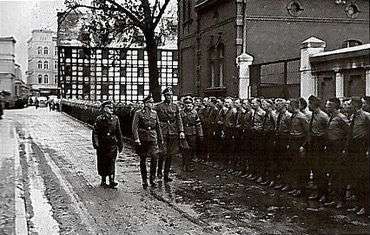Volksdeutsche
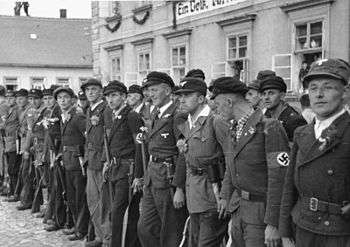


In terminology of Nazi Germany, Volksdeutsche (German pronunciation: [ˈfɔlksˌdɔʏtʃə]) were "Germans in terms of people or race", regardless of citizenship. The term is the nominalised plural of volksdeutsch, with Volksdeutsche denoting a singular female, and Volksdeutsche(r), a singular male. The words Volk and völkisch conveyed the meanings of "folk" and "race" while adding the sense of superior civilisation and blood.[1] These terms were used by Nazis to define people on the basis of their outdated misconception that they were a unique 'race' although in modern terminology, this is their ethnicity rather than citizenship and thus included Germans living beyond the borders of the Reich, as long as they were not of Jewish origin.[2] This is in contrast to Imperial Germans (Reichsdeutsche), German citizens living within Germany. The term also contrasts with the usage of the term Auslandsdeutsche (Germans abroad/German expatriate) since 1936, which generally denotes German citizens residing in other countries.[3] The difference between 'Imperial German' and 'Ethnic German' was that those designated as being ethnic Germans did not have paperwork to prove their legal citizenship to work or vote within the country though some were from either Germany or lost territories of Germany taken during and after the First World War.
Volksdeutsche were further divided into 'racial' groups—a minority within a minority in a state—with a special cultural, social and historic development as described by Nazis.[4]
Origin of the term
According to the historian Doris Bergen, Adolf Hitler is reputed to have coined the definition of "Volksdeutsche" which appeared in a 1938 memorandum of the German Reich Chancellery. In that document, the Volksdeutsche were defined as "races whose language and culture had German origins but who did not hold German citizenship." After 1945 the Nazi laws of 1935 in Germany and their relevant paragraphs that referred to the National Socialist concepts of blood and race in connection with the concept of volksdeutsch were rescinded.
For Hitler and the other ethnic Germans of his time, the term "Volksdeutsche" also carried overtones of blood and race not captured in the common English translation "ethnic Germans". According to German estimates in the 1930s, about 30 million Volksdeutsche and Auslandsdeutsche (German citizens residing abroad, see McKale 1977: The Swastika Outside Germany, p. 4) were living outside the Reich. A significant proportion of them were in Central Europe: Poland, Ukraine, the Baltic states, and Romania, Hungary and Yugoslavia, where many were located in villages along the Danube, and Russia. Many of their ancestors had migrated to non-German-speaking European countries in the 18th century, invited by governments that wanted to repopulate areas decimated by the Ottoman Empire occupation and sometimes by disease.
The Nazi goal of expansion assigned the Volksdeutsche a special role in German plans, to bring them back to German citizenship and elevate them to power over the native populations in those areas. The Nazis detailed such goals in Generalplan Ost.[5]
Historical background
In the sixteenth century Vasili III invited small numbers of craftsmen, traders and professionals to settle in Russia from areas that would later become Germany so that Muscovy could exploit their skills. These settlers (many of whom intended to stay only temporarily) were generally confined to the German Quarter in Moscow (which also included Dutch, British and other western or northern European settlers whom the Russians came to indiscriminately refer to as "Germans"). They were only gradually allowed in other cities, so as to prevent the spread of alien ideas to the general population.
In his youth, Peter the Great spent much time in the 'German' quarter. When he became Tsar, he brought more German experts (and other foreigners) into Russia, and particularly into government service, in his attempts to westernise the empire. He also brought in German engineers to supervise the construction of the new city of Saint Petersburg.
Catherine the Great, herself ethnically German, invited Germanic farmers to immigrate and settle in Russian lands along the Volga River. She guaranteed them the right to retain their language, religion and culture. Ethnic Germans were also sent by her in organised colonisation attempts aiming at Germanisation of conquered Polish areas.
Also in other areas with an ethnic German minority people of other than German descent assimilated with the ethnic German culture and formed then a part of the minority. Examples are people of Baltic and Scandinavian descent, who assimilated into the minority of the Baltic Germans. Jews of Posen province, Galicia, Bukovina and Bohemia, with their Yiddish culture derived in part from their German heritage, often mingled into the ethnic German culture, thus forming part of the various ethnic German minorities. But anti-Semitic Nazis later rejected Jewish ethnic Germans and all Jewish German citizens as 'racially' German.
Frederick the Great (reigned 1740–1786) settled around 300,000 colonists in the eastern provinces of Prussia, acquired in the First Partition of Poland of 1772, with the intention of replacing the Polish nobility. He treated the Poles with contempt and likened the "slovenly Polish trash" in newly occupied West Prussia to Iroquois, the historic Native American confederacy based in the state of New York.[6][7]
Prussia encouraged a second round of colonisation with the goal of Germanisation after 1832.[8] Prussia passed laws to encourage Germanisation of the Prussian Partition including the provinces of Posen and West Prussia in the late 19th century. The Prussian Settlement Commission relocated 154,000 colonists, including locals.
Treaty of Versailles
The reconstitution of Poland following the Treaty of Versailles (1919) made ethnic German minorities of some Prussian provinces of the German Empire citizens of the Polishnation state. Ethnic German inhabitants of provinces of the dissolved Austro-Hungarian Empire, such as Bukovina Germans, Danube Swabians, Sudeten Germans and Transylvanian Saxons, became citizens of newly established Slavic or Magyar nation-states and of Romania. Tensions between the new administration and the ethnic German minority arose in the Polish Corridor. The Austrian Germans also found themselves not allowed to join Germany as German Austria was strictly forbidden to join Germany as well as the name "German Austria" was forbidden so the name was changed back to just "Austria" and the First Austrian Republic was created in 1919.
The Nazi era before World War II
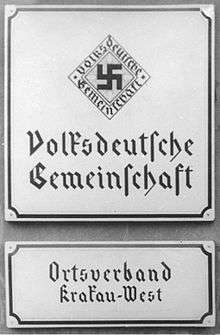
During the Nazi years, the German Nazis used the term "Volksdeutsche", by which they meant racially German since they mistakenly believed in a German 'race' or 'Volk', to refer to foreign nationals of some German ethnicity living in countries newly occupied by Nazi Germany or the Soviet Union. Prior to World War II, more than 10 million ethnic Germans lived in Central and Eastern Europe. They constituted an important minority far into Russia. Because of widespread assimilation some people whom the Nazis called Volksdeutsche could no longer speak German and in fact were culturally regionalized as Poles, Hungarians, Romanians, Czechs, Slovaks, etc.
Pre-war relations with the Nazis
In 1931, prior to its rise to power, the Nazi party established the Auslandsorganisation der NSDAP/AO (Foreign Organisation of the Nazi Party), whose task it was to disseminate Nazi propaganda among the ethnic German minorities viewed as Volksdeutsche in Nazi ideology. In 1936, the government set up the Volksdeutsche Mittelstelle (Ethnic Germans' Liaison Office), commonly known as VoMi, under the jurisdiction of the SS as the liaison bureau. It was headed by SS-Obergruppenführer Werner Lorenz.
In 1936 the Nazis set up an office to act as a contact for the foreign ethnic Germans. According to the historian Valdis Lumans,
- "[one of Himmler's goals was] centralising control over the myriad of groups and individuals inside the Reich promoting the Volksdeutsche cause. Himmler did not initiate the process but rather discovered it in progress and directed it to its conclusion and to his advantage. His principal instrument in this effort was an office from outside the SS, a Nazi party organ, the Volksdeutsche Mittelstelle (VoMi), translated as the Ethnic German Liaison Office."[9]
Internal propaganda
Nazi propaganda used the existence of ethnic Germans who they called Volksdeutsche in foreign lands before and during the war, to help justify the aggression of Nazi Germany. The annexation of Poland was presented as necessary to protect the ethnic German minorities there.[10] Massacres of ethnic Germans, such as Bloody Sunday, or alleged atrocities, were used in such propaganda, and the film Heimkehr drew on such putative events as the rescue of Volksdeutsche by the arrival of German tanks.[11] Heimkehr's introduction explicitly states that hundreds of thousands of Poles of German ethnicity suffered as the characters in the film did.[12]
Menschen im Sturm reprised Heimkehr's effort to justify the invasion of Slavonia, using many of the same atrocities.[13] In The Red Terror, a Baltic German is able to avenge her family's deaths, but commits suicide after, unable to live with meaning in the Soviet Union.[14] Flüchtlinge depicted the sufferings of Volga German refugees in Manchuria, and how a heroic blond leader saved them; it was the first movie to win the state prize.[15] Friesennot depicted the suffering of a village of Volga Germans in the Soviet Union;[16] it also depicted the murder of a young woman for an affair with a Russian—in accordance with Nazi principle of Rassenschande—as an ancient German custom.[17]
Sexual contact between what the Nazis viewed as different 'races' followed by remorse and guilt was also featured in Die goldene Stadt, where the Sudeten German heroine faces not persecution but the allure of the big city;[18] when she succumbs, in defiance of blood and soil, she is seduced and abandoned by a Czech, and such a relationship leads to her drowning herself.[19]
Collaboration with the Nazis
Before and during World War II, some ethnic Germans gathered around local Nazi organizations (sponsored financially by the Ministry of Foreign Affairs of the Third Reich),[20][21] actively supported the Nazis in countries such as Czechoslovakia, Poland and Yugoslavia. During the social and economic tensions of the Great Depression, some had begun to feel aggrieved with their minority status. They participated in espionage, sabotage and other Fifth column means in their countries of origin, trained and commanded by Abwehr.[22] In November 1938 Nazi Germany organized German paramilitary units made out German minority members in Polish Pomerania that were to engage in diversion, sabotage as well as political murder and ethnic cleansing upon German invasion of Poland.[23] Reich intelligence was actively recruiting ethnic Germans and the Nazi secret service "SicherheitsDienst" (SD) was forming them as early as October 1938 into armed unit that were to serve Nazi Germany[24] Historian Matthias Fiedler typified ethnic German collaborationists as former "nobodies" whose major occupation was the expropriation of Jewish property.[25] Heinrich Himmler remarked that whatever objections ethnic Germans might have against serving in the Waffen-SS, they would be forced into conscription in any case.[26] According to head of recruitment for the Waffen SS, Gottlob Berger, no one in Germany or elsewhere cared for what happened with the ethnic Germans anyway, making forced recruitment easy to force upon ethnic German communities.[27]
Among the indigenous populations in the Nazi-occupied lands, Volksdeutsche became a term of ignominy.
During the early years of the Second World War (i.e., before the US entered the war), a small number of Americans of German origin returned to Germany; generally they were immigrants or children of immigrants, rather than descendants of migrations more distant in time. Some of these enlisted and fought in the German army.
During World War II
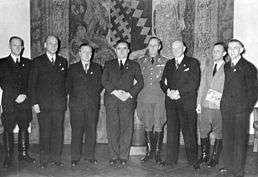
The Volskdeutsche during Second World War benefited from Nazi policies of genocide and ethnic cleansing and profited from expulsion and murder of their non-German neighbors.[28] In Ukraine the Volksdeutsche directly participated in the Holocaust and were involved in deportation of Ukrainian farmers and their families; Volksdeutsche figures like Arthur Boss or Becker brothers became integral part of Nazi Holocaust machine [29]
Volksdeutsche in German-occupied western Poland

In September 1939 in German occupied Poland, an armed ethnic German militia called Selbstschutz (Self-Defence) was created. It organised the mass murder of Polish elites in Operation Tannenberg. At the beginning of 1940, the Selbstschutz was disbanded and its members transferred to various units of the SS and German police. Throughout the invasion of Poland, some ethnic German minority groups assisted Nazi Germany in the war effort. They committed sabotage, diverted regular forces and committed numerous atrocities against civilian population.[30][31]
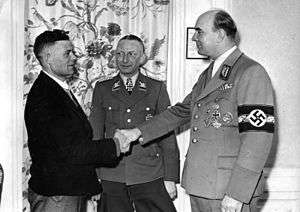
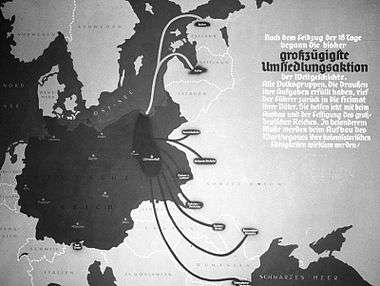
After Germany occupied western Poland, it established a central registration bureau, called the German People's List (Deutsche Volksliste, DVL), whereby Poles of German ethnicity were registered as Volksdeutsche. The German occupants encouraged such registration, in many cases forcing it or subjecting Poles of German ethnicity to terror assaults if they refused.[32] Those who joined this group were given benefits, including better food as well as a better social status.
The Volksdeutsche Mittelstelle organised large-scale looting of property and redistributed goods to the Volksdeutsche. They were given apartments, workshops, farms, furniture, and clothing confiscated from Jewish Poles and Poles of Polish ethnicity. In turn, hundreds of thousands of the Volksdeutsche joined the German forces, either willingly or under compulsion.
During World War II, Polish citizens of German ancestry, who often identified with the Polish nation, were confronted with the dilemma of registering in the Deutsche Volksliste. Many ethnic Germans had families who had lived in Poland for centuries; even the more recent immigrants had arrived 30 years or more before the war. They faced the choice of registering and being regarded as traitors by other Poles, or not signing and being treated by the Nazi occupation as traitors to the Germanic "race".
Polish Silesian Catholic Church authorities, led by bishop Stanisław Adamski and with agreement from the Polish Government in Exile, advised Poles to sign up to the Volksliste in order to avoid atrocities and mass murder that happened in other parts of the country.[33]
In occupied Poland, the status of "Volksdeutscher" gave many privileges, but one big disadvantage: Volksdeutsche were subject to conscription into the German army. In occupied Pomerania, the Gauleiter of the Danzig-West Prussia region Albert Forster issued a secret order which mandated a creation of a list of people who were considered to be of German ethnicity, in 1941. Since the number of supposedly ethnic Germans who signed up voluntarily was insignificant by 1942, in February of that year Forster made signing of the Volksliste mandatory and empowered local police and other authorities to employ various methods, including physical force and threats, to implement the decree. Consequently, the initially insignificant number of signatories rose to almost a million persons, or about 55% of the population by 1944. The special case of Polish Pomerania, where terror against civilians was particularly intense, and where, unlike in rest of occupied Poland, signing of the list was mandatory for many people, was recognised by the Polish Underground State and other anti-Nazi resistance movements, which tried to explain the situation to other Poles in underground publications.[34]
The Deutsche Volksliste categorised non-Jewish Poles of German ethnicity into one of four categories:[35][36]
- Category I: Persons of German descent committed to the Reich before 1939.
- Category II: Persons of German descent who had remained passive.
- Category III: Persons of German descent who had become partly "Polonised", e.g., through marrying a Polish partner or through working relationships (especially Silesians and Kashubians).
- Category IV: Persons of German ancestry who had become "Polonised" but were supportive of "Germanisation".
Volksdeutsche of statuses 1 and 2 in the Polish areas annexed by Germany numbered 1,000,000, and Nos. 3 and 4 numbered 1,700,000. In the General Government there were 120,000 Volksdeutsche. Volksdeutsche of Polish ethnic origins were treated by the Poles with special contempt, but were also committing high treason according to Polish law.
| Annexed area | Deutsche Volksliste, early 1944 | |||
| Cat. I | Cat. II | Cat. III | Cat. IV | |
| Warthegau | 230,000 | 190,000 | 65,000 | 25,000 |
| Reichsgau Danzig-West Prussia Note: In Polish Pomerania, unlike in the rest of occupied Poland, signing of the list was mandatory for a good portion of the population.[34] |
115,000 | 95,000 | 725,000 | 2,000 |
| East Upper Silesia | 130,000 | 210,000 | 875,000 | 55,000 |
| South East Prussia | 9,000 | 22,000 | 13,000 | 1,000 |
| Total | 484,000 | 517,000 | 1,678,000 | 83,000 |
| Total 2.75 million on Volkslisten plus non-German population (Polish) of 6.015 million- Grand Total 8.765 million in annexed territories. | ||||
| Source: Wilhelm Deist, Bernhard R Kroener, Germany (Federal Republic). Militärgeschichtliches Forschungsamt, Germany and the Second World War, Oxford University Press, 2003, pp. 132,133, ISBN 0-19-820873-1, citing Broszat, Nationalsozialistische Polenpolitik, p. 134 | ||||
Because of actions by some Volksdeutsche and particularly the atrocities committed by Nazi Germany, after the end of the war, the Polish authorities tried many Volksdeutsche for high treason. In the postwar period, many other ethnic Germans were expelled to the west and forced to leave everything. In post-war Poland, the word Volksdeutsche is regarded as an insult, synonymous with "traitor".
In some cases, individuals consulted the Polish resistance first, before signing the Volksliste. There were Volksdeutsche who played important roles in intelligence activities of the Polish resistance, and were at times the primary source of information for the Allies. Particularly in Polish Pomerania and Polish Silesia, many of the people who were forced to sign the Volksliste played crucial roles in the anti-Nazi underground, which was noted in a memo to the Polish Government in Exile which stated "In Wielkopolska there's bitter hatred of the Volksdeutshe while in Silesia and Polish Pomerania it's the opposite, the secret organization depends in large measure on the Volksdeutshe" (the memo referred to those of Category III, not I and II).[34] In the turmoil of the postwar years, the Communist government did not consider this sufficient mitigation. It prosecuted many double-agent Volksdeutsche and sentenced some to death.
Volksdeutsche in the territories annexed by the Soviet Union in 1939–1940
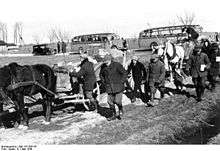
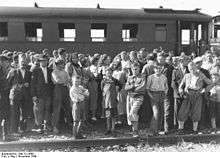


The Soviet invasion of Finland, which had been covertly ceded under the Molotov-Ribbentrop Pact secret protocols, created domestic problems for Hitler.[38] Supporting the Soviet invasion became one of the most ideologically difficult aspects of the countries' relationship.[39] The secret protocols caused Hitler to hurriedly evacuate ethnic German families, who had lived in Finland and the Baltic countries for centuries and now classified as Volksdeutsche, while officially condoning the invasions.[40][41] When the three Baltic countries, not knowing about the secret protocols, sent letters protesting the Soviet invasions to Berlin, Ribbentrop returned them.[42]
In August 1940, Soviet Foreign minister Molotov told the Germans that, with the government change, they could close down their Baltic consulates by 1 September.[42] The Soviet annexations in Romania caused further strain.[42] While Germany had given the Soviets Bessarabia in the secret protocols, it had not given them North Bukovina.[42] Germany wanted guarantees of the safety of property of ethnic Germans, security for the 125,000 Volksdeutsche in Bessarabia and North Bukovina, and reassurance that the train tracks carrying Romanian oil would be left alone.[41]
In October 1940, Germany and the Soviet Union negotiated about the Volksdeutsche in Soviet-occupied territories and their property.[43] Instead of permitting full indemnification, the Soviets put restrictions on the wealth that the Volksdeutsche could take with them and limited the totals that the Soviets would apply to the Reich's clearing accounts.[44] The parties discussed total compensation of between 200 million and 350 million Reichsmarks for the Volksdeutsche, while the Soviets requested 50 million Reichsmarks for their property claims in German-occupied territories.[45] The two nations reached general agreement on German shipments of 10.5-cm flak cannons, gold, machinery and other items.[45]
On 10 January 1941, Germany and the Soviet Union signed the German–Soviet Border and Commercial Agreement to settle all of the open disputes which the Soviets had argued.[46] The agreement covered protected migration to Germany within two and a half months of Volksdeutsche, and similar migration to the Soviet Union of ethnic Russians, Baltic and "White Russian" "nationals" from German-held territories.[47] In many cases, the resulting population transfers resulted in resettlement of Volksdeutsche on land previously held by ethnic Poles or Jews in now Nazi-occupied territories. The agreement formally defined the border between Germany and the Soviet Union areas between the Igorka River and the Baltic Sea.[47]
| Territory of origin | Year | Number of resettled Volksdeutsche |
|---|---|---|
| South Tyrol (see South Tyrol Option Agreement) | 1939–1940 | 83,000 |
| Latvia and Estonia | 1939–1941 | 69,000 |
| Lithuania | 1941 | 54,000 |
| Volhynia, Galicia, Nerewdeutschland | 1939–1940 | 128,000 |
| General Government | 1940 | 33,000 |
| North Bukovina and Bessarabia | 1940 | 137,000 |
| Romania (South Bukovina and North Dobruja) | 1940 | 77,000 |
| Yugoslavia | 1941–1942 | 36,000 |
| USSR (pre-1939 borders) | 1939–1944 | 250,000 |
| Summary | 1939–1944 | 867,000 |
After the German invasion of the USSR
After the Russian Revolution of 1917, the government granted the Volga Germans an autonomous republic. Joseph Stalin abolished the Volga German ASSR after Operation Barbarossa, the German invasion of the USSR. Most of Soviet Germans in the USSR were deported to Siberia, Kazakhstan, and Central Asia by Decree of the Supreme Soviet of the USSR of August 28, 1941, and from the beginning of 1942 those Soviet Germans who were deemed suitable for hard work (men aged from 15 to 55 and women from 16 to 45) were mobilised for forced labour into Working columns where they lived in a prison-like environment, and sometimes, together with regular inmates, were put in prison camps. Hundreds of thousands died or became incapacitated due to the harsh conditions.
Volksdeutsche in Hungary
A significant portion of Volksdeutsche in Hungary joined the SS, which was a pattern repeated oft in Europe. The majority of 200,000 Volksdeutsche from the area of Danube who served with the SS were from Hungary, and as early as 1942, 18,000 Hungarian Germans joined the SS.[49] Some called themselves Shwova and were called 'Svabo' by their Serbian, Hungarian, Croatian, and Romanian neighbors, especially in the area now part of the Vojvodina in Serbia. Others of the approximately 900,000 ethnic Germans in Hungary during World War II were Siebenburger Saxons. Today they have virtually all become assimilated or left the region. In the diaspora, they have been called Danube Swabians.
Volksdeutsche in Romania
After Romania acquired parts of Soviet Ukraine, the Germans there came under the authority of the Volksdeutsche Mittelstelle, which deployed SS personnel to several settlements. They eventually contained German mayors, farms, schools and ethnic German paramilitary groups functioning as police called Selbstschutz ("Self-protection"). German colonists and Selbstschutz forces engaged in extensive acts of ethnic cleansing, massacring Jewish and Roma populations.
In the German colony of Shonfeld, Romas were burned in farms. During the winter of 1941/1942, German Selbstschutz units participated in the shooting, together with Ukrainian People's Militia and Romanian gendarmes, of some 18,000 Jews. In the camp of Bogdanovka, tens of thousands of Jews were subject to mass shootings, barn burnings and killing by hand grenades.
Heinrich Himmler was sufficiently impressed by the Volksdeutsche communities and the work of the Selbstschutz to order that these methods be copied in Ukraine.[50]
Volksdeutsche in Yugoslavia
In Yugoslavia, the 7th SS Volunteer Mountain Division Prinz Eugen was formed. It was conspicuous in its operations against the Resistance partisans and among the population. About 300,000 Volksdeutsche from the Nazi-conquered lands and the satellite countries joined the Waffen-SS, the majority conscripted involuntarily. Yet "[a]fter the initial rush of Volksdeutsche to join, voluntary enlistments tapered off, and the new unit did not reach division size. Therefore, in August 1941, the SS discarded the voluntary approach, and after a favourable judgement from the SS court in Belgrade, imposed a mandatory military obligation on all Volksdeutsche in Serbia-Banat, the first of its kind for non-Reich Germans."[51] In Yugoslavia for example, not even half of the Volksdeutsche became member of the Schwäbisch-Deutscher Kulturbund (German cultural association), yet reprisals on this group were more harsh than in any other region.[52]
Expulsion and exodus from Central and Eastern Europe at the end of the war

Most Volksdeutsche fled or were expelled from European countries (the Netherlands, Poland and other) from 1945 to 1948 towards the end and after the war. Both those who became Volksdeutsche by registering and Reichsdeutsche retained German citizenship during the years of Allied military occupation, after the establishment of East Germany and West Germany in 1949, and later in the reunified Germany. In 1953 the Federal Republic of Germany - by its Federal Expellee Law - naturalised many more East European nationals of German ethnicity, who neither were German citizens nor had enrolled in a Volksliste, but as a matter of fact had been stranded as refugees in West Germany fled or expelled due to their German or alleged German ethnicity.
An estimated 12 million people fled or were expelled from the Soviet Union and non-German-speaking Central Europe, many of them being Volksdeutsche.[53][54][55][56] Most left the Soviet-occupied territories of Central and Eastern Europe; they comprised the largest migration of any European people in modern history.[54][57] The then three Allies had agreed to the expulsions during negotiations in the midst of war. The western powers hoped to avoid ethnic Germans being an issue again in Central and Eastern Europe.[58][59][60] The three Allies at the Conference of Potsdam considered the "transfer" of "German populations" from Czechoslovakia, Poland and Hungary an effort to be undertaken (see article 12 of the Potsdam Agreement), although they asked a halt because of the inflicted burden for the Allies to feed and house the destitute expellees and to share that burden among the Allies. France, which was not represented in Potsdam, rejected the decision of the Three of Potsdam and did not absorb expellees in its zone of occupation. The three Allies had to accept the reality on the ground, since expulsions of Volksdeutsche and Central and Eastern European nationals of German or alleged German ethnicity who never had enrolled as Volksdeutsche, was going on already.
Local authorities forced most of the remaining ethnic Germans to leave between 1945 and 1950. Remnants of the ethnic German community survive in the former Soviet republics of Central Asia. A significant ethnic German community has continued in Siebenbürgen (Transylvania) in Romania and in Oberschlesien (Upper Silesia) but most of it migrated to West Germany throughout the 1980s. There are also remnant German populations near Mukachevo in western Ukraine.[61]
Legacy
The term is generally avoided today due to its usage by the Nazis.
Instead, ethnic Germans of foreign citizenship living outside of Germany are called "Deutsche Minderheit" (meaning "German minority"), or names more closely associated with their earlier places of residence, such as Wolgadeutsche or Volga Germans, the ethnic Germans living in the Volga basin in Russia; and Baltic Germans, who generally called themselves Balts, and Estländer in Estonia. They were relocated to German-occupied Poland during World War II by an agreement between Adolf Hitler and Joseph Stalin, and most were expelled to the West after the war, under an allied accord called the Potsdam Agreement.
See also
- Areas annexed by Nazi Germany
- Germans Abroad
- Goralenvolk
- Selbstschutz
- Imperial Germans, for a discussion of the different concepts and the shift of meaning between them.
- Fifth column
- Heimatvertriebene
- Umvolkung
- Flight and expulsion of Germans (1944–1950)
- Demographic estimates of the flight and expulsion of Germans
- World War II evacuation and expulsion
- Pursuit of Nazi collaborators
- Nur für Deutsche
- Brandenburgers
Notes
- ↑ As to older meanings of völkisch see Völkisch movement.
- ↑ The Greenwood Encyclopedia of International Relations: S-Z Cathal J. Nolan, page 1793, 2002
- ↑ Vokabular des Nationalsozialismus by Cornelia Schmitz-Berning 1998, page 651
- ↑ Himmler's Auxiliaries: The Volksdeutsche Mittelstelle and the German National Minorities of Europe, 1933-1945 by Valdis O. Lumans 1993, page 23
- ↑ Bergen, Doris. "The Nazi Concept of 'Volksdeutsche' and the Exacerbation of Anti-Semitism in Eastern Europe, 1939-45", Journal of Contemporary History, Vol. 29, No. 4 (Oct. 1994), pp. 569-582
- ↑ Ritter, Gerhard (1974), Frederick the Great: A Historical Profile, Berkeley: University of California Press, pp. 179–180, ISBN 0-520-02775-2,
It has been estimated that during his reign 300,000 individuals settled in Prussia.... While the Prussian Settlement Commission established in the Bismarck era could in the course of two decades bring no more than 11,957 families to the eastern territories, Frederick settled a total of 57,475.... It increased the German character of the population in the monarchy's provinces to a very significant degree.... in West Prussia where he wished to drive out the Polish nobility and bring as many of their large estates as possible into German hands.
- ↑ "In fact from Hitler to Hans we find frequent references to Poles and Jews as Indians. This, too, was a long standing trope. It can be traced back to Frederick the Great, who likened the 'slovenly Polish trash' in newly' reconquered West Prussia to Iroquois". David Blackbourn, James N. Retallack, Localism, Landscape, and the Ambiguities of Place: German-speaking Central Europe, 1860-1930, University of Toronto, 2007
- ↑ Wielka historia Polski t. 4 Polska w czasach walk o niepodległość (1815–1864). Od niewoli do niepodległości (1864–1918)Marian Zagórniak, Józef Buszko 2003 page 186
- ↑ Lumans Valdis, Himmler's Auxiliaries: The Volksdeutsche Mittelstelle and the German National Minorities of Europe, 1933-1945, Chapel Hill, NC and London: University of North Carolina Press,
- ↑ Cinzia Romani, Tainted Goddesses: Female Film Stars of the Third Reich p145 ISBN 0-9627613-1-1
- ↑ Robert Edwin Hertzstein, The War That Hitler Won p289 ISBN 0-399-11845-4
- ↑ Robert Edwin Hertzstein, The War That Hitler Won p287 ISBN 0-399-11845-4
- ↑ Robert Edwin Hertzstein, The War That Hitler Won p292-3 ISBN 0-399-11845-4
- ↑ Erwin Leiser, Nazi Cinema pp 44-5 ISBN 0-02-570230-0
- ↑ Erwin Leiser, Nazi Cinema p29-30 ISBN 0-02-570230-0
- ↑ Erwin Leiser, Nazi Cinema p39-40 ISBN 0-02-570230-0
- ↑ Richard Grunberger, The 12-Year Reich, p 384, ISBN 0-03-076435-1
- ↑ Cinzia Romani, Tainted Goddesses: Female Film Stars of the Third Reich p86 ISBN 0-9627613-1-1
- ↑ Anthony Rhodes, Propaganda: The art of persuasion: World War II, p20 1976, Chelsea House Publishers, New York
- ↑ H. Kennard to Viscount Halifax (August 24, 1939). "The British War Bluebook". 2008 Lillian Goldman Law Library. Retrieved 11 September 2014.
- ↑ Wacław Uruszczak (2012). Krakowskie Studia z Historii Państwa i Prawa Vol. 5. Wydawnictwo UJ. p. 339. ISBN 8323388687.
- ↑ Józef Kossecki (1997). "II Oddział Sztabu Głównego II RP (Chapter 3.3)" (PDF). Totalna wojna informacyjna XX wieku a II RP. Kielce: Wydział Zarządzania i Administracji Wyższej Szkoły Pedagogicznej im. J. Kochanowskiego w Kielcach: 102 – via direct download, 808 KB.
- ↑ Konrad Ciechanowski (1988). Stutthof: hitlerowski obóz koncentracyjny. Wydawnictwo Interpress. p. 13.
- ↑ Himmler's Auxiliaries: The Volksdeutsche Mittelstelle and the German National Minorities of Europe, 1933-1945 Valdis O. Lumans page 98
- ↑ Wittmann, A.M., "Mutiny in the Balkans: Croat Volksdeutsche, the Waffen-SS and Motherhood", East European Quarterly XXXVI No. 3 (2002), p. 257
- ↑ Wittmann, A.M., "Mutiny in the Balkans: Croat Volksdeutsche, the Waffen-SS and Motherhood", East European Quarterly XXXVI No. 3 (2002), p. 258
- ↑ Wittmann, A.M., "Mutiny in the Balkans: Croat Volksdeutsche, the Waffen-SS and Motherhood", East European Quarterly XXXVI No. 3 (2002), p. 259
- ↑ German Diasporic Experiences: Identity, Migration, and Loss Mathias Schulze page 126
- ↑ Gray Zones: Ambiguity and Compromise in the Holocaust and Its Aftermath Jonathan Petropoulos,John K. Roth page 199
- ↑ Maria Wardzyńska, Był rok 1939 Operacja niemieckiej policji bezpieczeństwa w Polsce. Intelligenzaktion, IPN Instytut Pamięci Narodowej, 2009 ISBN 978-83-7629-063-8
- ↑ Browning, Christopher R. The Origins of the Final Solution: The Evolution of Nazi Jewish Policy, September 1939-March 1942, 2007 p. 33
- ↑ Historia Encyklopedia Szkolna, Wydawnictwa Szkolne i, Warszawa" Pedagogiczne, 1993, pp. 357, 358
- ↑ Historia społeczno-polityczna Górnego Śląska i Śląska w latach 1918-1945 Maria Wanatowicz - 1994 Wydawnictwo Uniwersytetu Śląskiego, 1994, p. 180
- 1 2 3 Chrzanowski, B., Gasiorowski, A., and Steyer, K. Polska Podziemna na Pomorzu w Latach 1939-1945 (Underground Polish State in Pomerania in the years 1939-1945), Oskar, Gdansk, 2005, pgs. 59-60
- ↑ Georg Hansen, Ethnische Schulpolitik im besetzten Polen: Der Mustergau Wartheland, Waxmann Verlag, 1995, pp. 30ff, ISBN 3-89325-300-9
- ↑ Bruno Wasser, Himmlers Raumplanung im Osten: Der Generalplan Ost in Polen, 1940-1944, Birkhäuser, 1993, pp. 109ff, ISBN 3-7643-2852-5
- ↑ Among the resettled people were the parents of Germany's former president Horst Köhler
- ↑ Philbin III 1994, p. 71
- ↑ Philbin III 1994, p. 129
- ↑ Shirer 1990, p. 665
- 1 2 Ericson 1999, p. 134
- 1 2 3 4 Shirer 1990, p. 794
- ↑ Ericson 1999, p. 144
- ↑ Ericson 1999, p. 138
- 1 2 Ericson 1999, p. 149
- ↑ Ericson 1999, p. 150
- 1 2 Johari, J.C., Soviet Diplomacy 1925-41: 1925-27, Anmol Publications PVT. LTD., 2000, ISBN 81-7488-491-2 pages 134-137
- ↑ Enzyklopädie Migration in Europa. Vom 17. Jahrhundert bis zur Gegenwart, Munich: K.J.Bade, 2007, ss. 1082–1083.
- ↑ Righting Wrongs in Eastern Europe Istvan S. Pogany, page 53
- ↑ Moses, Dirk A. (editor) Empire, Colony, Genocide: Conquest, Occupation and Subaltern Resistance in World History, Berghahn Books, December 2009, ISBN 978-1845457198, p. 389
- ↑ Valdis O. Lumans, Himmler's Auxiliaries: The Volksdeutsche Mittelstelle and the German National minorities of Europe, 1939-1945 (University of North Carolina Press, 1993), page.235.
- ↑ Wittmann, A.M., "Mutiny in the Balkans: Croat Volksdeutsche, the Waffen-SS and Motherhood", East European Quarterly XXXVI No. 3 (2002), p. 256-257
- ↑ Jürgen Weber, Germany, 1945-1990: A Parallel History, Central European University Press, 2004, p.2, ISBN 963-9241-70-9
- 1 2 Arie Marcelo Kacowicz, Pawel Lutomski, Population resettlement in international conflicts: a comparative study, Lexington Books, 2007, p.100, ISBN 0-7391-1607-X: "… largest movement of any European people in modern history"
- ↑ Peter H. Schuck, Rainer Münz, Paths to Inclusion: The Integration of Migrants in the United States and Germany, Berghahn Books, 1997, p.156, ISBN 1-57181-092-7
- ↑ The Expulsion of 'German' Communities from Central and Eastern Europe at the end of the Second World War, Steffen Prauser and Arfon Rees, European University Institute, Florense. HEC No. 2004/1. p.4
- ↑ Bernard Wasserstein, Barbarism and civilization: a history of Europe in our time, Oxford University Press, 2007, p.419: "largest population movement between European countries in the twentieth century and one of the largest of all time." ISBN 0-19-873074-8
- ↑ Text of Churchill Speech in Commons on Soviet=Polish Frontier, The United Press, December 15, 1944
- ↑ Detlef Brandes, Der Weg zur Vertreibung 1938-1945: Pläne und Entscheidungen zum "Transfer" der Deutschen aus der Tschechoslowakei und aus Polen, Munich: Oldenbourg Wissenschaftsverlag, 2005, pp. 398ff, ISBN 3-486-56731-4
- ↑ Klaus Rehbein, Die westdeutsche Oder/Neisse-Debatte: Hintergründe, Prozess und Ende des Bonner Tabus, Berlin, Hamburg and Münster: LIT Verlag , 2005, pp. 19,20, ISBN 3-8258-9340-5
- ↑ Grushenko, Kateryna. Kyiv Post. Oct 14, 2010. World in Ukraine: German heritage alive in Transcarpathian Ukraine. http://www.kyivpost.com/news/guide/world-in-uktaine/detail/86372/
References
- Ericson, Edward E. (1999), Feeding the German Eagle: Soviet Economic Aid to Nazi Germany, 1933-1941, Greenwood Publishing Group, ISBN 0-275-96337-3
- Philbin III, Tobias R. (1994), The Lure of Neptune: German-Soviet Naval Collaboration and Ambitions, 1919–1941, University of South Carolina Press, ISBN 0-87249-992-8
- Roberts, Geoffrey (2006), Stalin's Wars: From World War to Cold War, 1939–1953, Yale University Press, ISBN 0-300-11204-1
Bibliography
- Nazi Fifth Column Activities: A List of References, Library of Congress, 1943
- The German fifth column in the Second World War, by L. de Jong
- The German Fifth Column in Poland, London: Hutchinson & Co Ltd,
- Luther, Tammo (2004): Volkstumspolitik des Deutschen Reiches 1933-1938. Die Auslanddeutschen im Spannungsfeld zwischen Traditionalisten und Nationalsozialisten, Stuttgart: Franz Steiner, 2004
- Douglas, R.M.: Orderly and Humane. The Expulsion of the Germans after the Second World War, Yale University Press, 2012. ISBN 978-0-300-16660-6.
- Franzel, Emil: Sudetendeutsche Geschichte, Mannheim: 1978. ISBN 3-8083-1141-X.
- Franzel, Emil: Die Sudetendeutschen, Munich: Aufstieg Verlag, 1980.
- Meixner, Rudolf, Geschichte der Sudetendeutschen, Nuremberg: 1988. ISBN 3-921332-97-4.
- Naimark, Norman: Ethnic Cleansing in Twentieth-Century Europe, Cambridge (MA): Harvard University Press, 2001.
- Oltmer, Jochen: "Heimkehr"? "Volksdeutsche fremder Staatsangehörigkeit" aus Ost-, Ostmittel- und Südosteuropa im deutschen Kaiserreich und in der Weimarer Republik, EGO – European History Online, Mainz: Institute of European History, 2011, retrieved: June 16, 2011.
- Prauser, Steffen and Rees, Arfon: The Expulsion of the "German" communities from Eastern Europe at the End of the 2nd World War, Florence: European University Institute, 2004.
